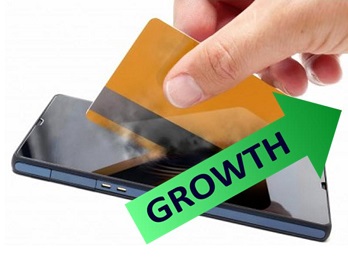Denny |
September 18, 2015
Report shows that women are beating men when it comes to mobile shopping
BI Intelligence has released a new report that shows that women are leading the way when it comes to mobile shopping. Women have shown that they are more willing to shop online with their mobile devices, as this represents a more convenient form of shopping. Mobile shopping is particularly prevalent during the holiday season, when consumers are interested in avoiding large crowds that flock to retail stores to get their shopping done.
Product research is more common among women than men
Of those shopping in the United States that have said they have made a purchase with a mobile device over the past month, 66.5% of them were women, with 33% of them being men. In 2013, men were leading when it comes to mobile shopping. They were also spending more money while using their mobile devices. The report shows that women are more actively researching products with their smartphones and tablets. They use their mobile devices to find the location of stores in their area as well.
Women seek out special offers more than men do
 The report shows that women are more likely to be affected by the offering of mobile coupons, which they can use to save money, and marketing campaigns. Women are more inclined to look for special deals that they can take advantage of and save money while mobile shopping. Men do this as well, but they are less likely to take advantage of deals being offered by retailers.
The report shows that women are more likely to be affected by the offering of mobile coupons, which they can use to save money, and marketing campaigns. Women are more inclined to look for special deals that they can take advantage of and save money while mobile shopping. Men do this as well, but they are less likely to take advantage of deals being offered by retailers.
Women may have a significant impact on how retailers engage the mobile commerce sector
Mobile commerce has become quite prominent in the United States, where many consumers have expressed interest in shopping for and purchasing products with their mobile devices. As women have become the dominant demographic when it comes to mobile shopping, retailers may be tailoring their marketing campaigns to engage women more directly. Women may also influence the way that retailers approach mobile commerce to some degree, as they represent a greater portion of the market.
BWild |
September 18, 2015
A recent study has forecasted that within a span of 7 years from now, the industry will reach $3 trillion.
The Bank of America Merrill Lynch has now released a report in which it has stated that in a period of 7 year, mobile payments will have grown by 200 times their previous size and will be worth more than $3 trillion.
If this prediction is correct, then wallet and banking apps, retailers, and telecoms are about to benefit greatly.
The report indicated that those who are most likely to benefit from this growth of mobile payments are: banking, telecom, IT, and mobile wallet firms. The report stated that “In India, we consider mobile payments to be both an opportunity (for banks, telcos and new players) and threat (due to dis-intermediation, more to the traditional banks). We estimate the value of mobile banking, estimated at just USD16 billion today to rise 200x in 7 years to more than USD 3,000 billion.”
It is also expected that mobile payments will make up 10 percent of the total transactions in that country.
 This is quite the increase, considering that for the 2015 financial year, smartphone payments made up only 0.1 percent of the total. The report stated that this will be a considerable opportunity for many companies involved in that industry to better their “competitive positioning.” Equally, the report noted that it would mean that there would suddenly be considerable competition making its way into the space that had previously been held by public sector banks.
This is quite the increase, considering that for the 2015 financial year, smartphone payments made up only 0.1 percent of the total. The report stated that this will be a considerable opportunity for many companies involved in that industry to better their “competitive positioning.” Equally, the report noted that it would mean that there would suddenly be considerable competition making its way into the space that had previously been held by public sector banks.
As the payments technology evolves, it is expected that the use of paper cash will have dropped to under 2 percent. The report predicted that the range of alternative methods of payment will lead to a gradual decrease in the use of cash throughout the economy, and that electronic payments will help to ease the lending rates and will encourage growth over time.
It pointed out that among the primary drivers behind the growth of the use of alternative transactions will be in the improvements of mobile payments through greater smartphone penetration. That penetration in India is expected to double in the country’s young population over the next three years. As 60 percent of the population is younger than 35 years old, this represents a massive shift in digital technology use.
 The report shows that women are more likely to be affected by the offering of mobile coupons, which they can use to save money, and marketing campaigns. Women are more inclined to look for special deals that they can take advantage of and save money while mobile shopping. Men do this as well, but they are less likely to take advantage of deals being offered by retailers.
The report shows that women are more likely to be affected by the offering of mobile coupons, which they can use to save money, and marketing campaigns. Women are more inclined to look for special deals that they can take advantage of and save money while mobile shopping. Men do this as well, but they are less likely to take advantage of deals being offered by retailers.
 This is quite the increase, considering that for the 2015 financial year, smartphone payments made up only 0.1 percent of the total. The report stated that this will be a considerable opportunity for many companies involved in that industry to better their “competitive positioning.” Equally, the report noted that it would mean that there would suddenly be considerable competition making its way into the space that had previously been held by public sector banks.
This is quite the increase, considering that for the 2015 financial year, smartphone payments made up only 0.1 percent of the total. The report stated that this will be a considerable opportunity for many companies involved in that industry to better their “competitive positioning.” Equally, the report noted that it would mean that there would suddenly be considerable competition making its way into the space that had previously been held by public sector banks.